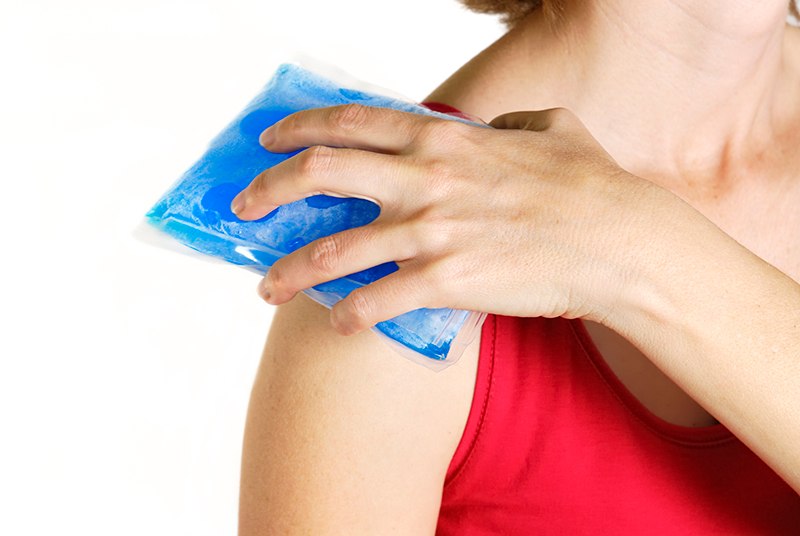
At The Orthopedic Center of Palm Beach County, Dr. Michael Cohn will carefully and expertly perform your shoulder replacement surgery. He welcomes second opinion consultations with regards to shoulder replacement surgery and would be happy to evaluate your individual case. You may undergo a total shoulder replacement, reverse total shoulder replacement, or another variation of shoulder replacement depending on your particular situation. The surgery typically takes about an hour.
Dr. Cohn believes in minimizing postoperative pain as best as possible. Your operated arm will be numb from the regional anesthesia, which also can provide good pain relief for the next day. In most cases, a long-acting local anesthetic will be infused at the surgical site before you wake up from anesthesia giving additional pain relief for 24-48 hours after surgery. An ice pad will also be applied to your shoulder before you wake up to help with pain and swelling.
After surgery, you will be moved into the recovery room where you will stay for approximately one hour. During this time, you will be monitored until you fully awaken from anesthesia. If done in the hospital setting, you will be taken to your hospital room. If your surgery is done as an outpatient, you will be discharged to home with a family member and will be monitored at home that evening by a visiting nurse.
After surgery, you will feel some pain that will be managed with medication to make you feel as comfortable as possible. When you are able to move your hand, begin making a fist and holding it for five seconds. This small exercise helps to keep your blood circulating and should be done frequently.
Your arm will be in a sling for four to six weeks after surgery, aside from physical therapy and home exercise sessions. This is to protect your shoulder replacement and to allow the soft tissues to heal around your shoulder.
Postoperative Concerns
Total shoulder replacement is a very successful operation and the 10-year survival rate is about 90 percent. Most patients end up with extremely functional shoulders and are able to return to the activities of daily living and low impact sports without pain. Any type of operation can have complications, although they are very rare. Complications of shoulder replacement surgery may include infection, bleeding, shoulder instability, tearing of the rotator cuff, fracture and loosening of the prosthesis. Most of these concerns can be minimized by carefully following the postoperative instructions.
Physical Therapy
Dr. Cohn will prescribe a physical therapy program for you on your first postoperative visit. The rehabilitation process will take 3-4 months typically and involves a progression of stretching and strengthening exercises to restore your shoulder’s function in a careful fashion.
Medications
You will be given prescriptions for pain medication and anti-inflammatory medicine. Use the pain medication only if you are experiencing pain. Take the anti-inflammatory as prescribed.
Caring for Your Incision
Keep your surgical dressing clean and dry. The dressing can be changed daily upon your discharge from the hospital with a dry gauze pad and Tegaderm (clear adhesive tape). It is common to have a small amount of blood on the dressing. Do not shower or go in the bath until you return for your follow-up appointment. The incision has not healed yet and getting the incision wet puts the shoulder at risk of infection. After the stitches are removed, you can take a shower and let the water run over the wound. Do not go into a tub or Jacuzzi to soak the wound for 3-4 weeks. Pat the wound dry after you finish showering and apply a new dressing during the first 3 weeks.
Physical Activity
You will experience some swelling and bruising of the hand and arm. This is normal and results from the swelling and bruising from your shoulder, which travels down the arm. It is recommended that you bend and straighten your elbow frequently and make a fist to help keep your circulation flowing and help speed the resolution of this normal process.
Your arm will still be in a sling and it is recommended that you wear it when you are in public or moving around. If you are reading, watching television or working at a desk, you may loosen it. When you are getting dressed, it is easiest to put your operated arm through the shirt sleeve first, then put your sling on. You may use your arm to perform normal daily activities, such as eating, writing or shaving, but you may not lift any items or reach out suddenly until you are instructed that it is okay to do so.
Six weeks after surgery you can probably resume driving if you feel safe in doing so. At this time, Dr. Cohn also may allow you to return to use of the operated arm at work, depending on how much physical activity is involved in your occupation. You will also start to strengthen your shoulder with physical therapy.
After 3-4 months, you can begin to return to exercise and non-contact sports such as golf. The longevity of your new shoulder can be greatly extended by avoiding heavy lifting and contact sports indefinitely.
Follow-Up
During the first year following your surgery, routine follow-up visits will be scheduled. You will be asked to return for annual visits thereafter to assess the status and function of your implant.





